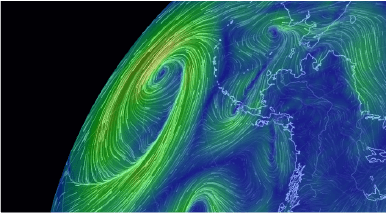The major power source for winds on the earth is the sun, which heats the equatorial regions significantly more than the polar ones. What this means is that air in the equatorial regions is warmed while air in the polar regions cools. The low-latitude warm air expands and rises (think of steam rising from a tea kettle) and heads toward the poles, creating what is termed a Hadley Cell. Meanwhile the high-latitude (polar) air has cooled and become denser, sinks, and flows toward the equator, creating a Polar Cell. To complicate matters, these single cells with an upper poleward wind and lower equatorward wind can break into 3 cells with the one in middle latitudes with lower warm air pushing poleward and upper cold air pushing equatorward (creating a “Ferrel Cell”). (For pictures see https://www.weather.gov/jetstream/circ.)
A second complication involves the earth’s rotation. Air speed is measured relative to the speed of the earth below it. The earth rotates toward the west so that the air speed relative to the earth effectively includes an eastward component from that rotation in addition to any other pressures, e.g., from topography. This eastward component is responsible for turning some of the thermally driven poleward or equatorward winds into jet streams. (For additional explanation and pictures see https://www.weather.gov/jetstream/jet.)
A third complication involves the earth’s topography, e.g., mountains through pushing air, and other surface features, e.g., oceans and water bodies through local heating or cooling. MIT Professor July Charney with some assistance from a UCLA grad student showed that that there are multiple flow equilibrium solutions to the equations of motion for atmospheric winds. (https://journals.ametsoc.org/view/journals/atsc/36/7/1520-0469_1979_036_1205_mfeita_2_0_co_2.xml.)
The “butterfly effect”, a term coined by meteorologist Edward Norton Lorentz, refers to the notion that small causes may have large effects in weather. (See https://en.wikipedia.org/wiki/Butterfly_effect.)
However, new research suggests that frigid arctic air outbursts may be predictable. (See https://www.climate.gov/news-features/feed/frigid-arctic-air-outbreaks-may-be-predictable-new-research-suggests.)



